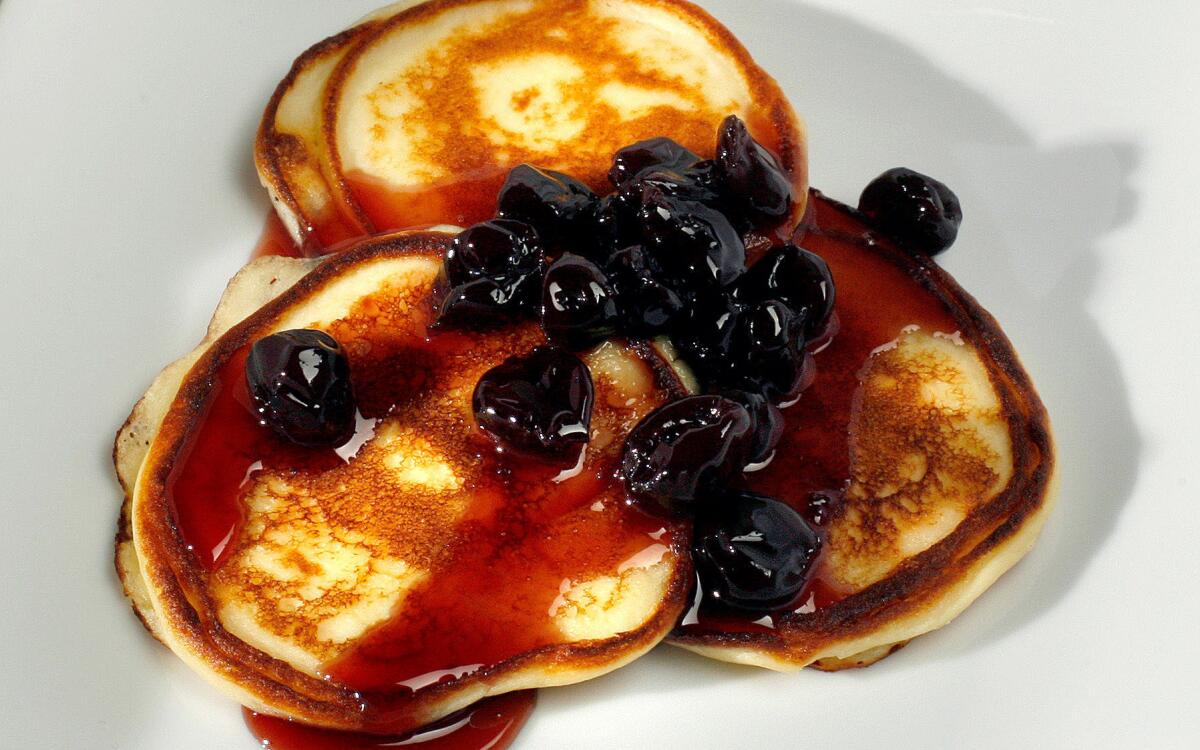Mini ricotta latkes with sour cherry sauce

“What makes a potato pancake a latke?” my younger daughter asked me last week, just before the eight-day Jewish festival of Hanukkah, which begins this year on Sunday evening (all Jewish holidays begin at sundown the day before). A latke, I explained to her, is not just a pancake made from potatoes, it’s a potato pancake with a poor man’s pedigree, a history, a tradition and a neshamah, a soul.
A lot to expect from a little pancake? Perhaps. But just as the menorah (originally an oil lamp) plays an integral part in the religious practice of the holiday, so does the potato latke, for most Ashkenazi Jews, play a starring role in the holiday’s culinary tradition.
But potato latkes weren’t originally a part of Hanukkah cuisine.
The holiday’s roots date back to 168 BC, when the Syrian-Greek King Antiochus captured Israel, plundering and defiling the holiest site of the Jewish people, the Temple in Jerusalem. On the outskirts of Jerusalem, guerrilla warriors led by the priest Mattathias and his five sons vowed never to submit. They called themselves the Maccabees -- derived from an acrostic of the Hebrew “Mi Kamocha B’Elim Adonai” (Who among the mighty is like you, God?) -- and indeed, they were victorious, liberating Jerusalem three years later.
Once the battle was over, the Maccabees rid the temple of idols and lighted the golden menorah with a little purified olive oil they found, apparently enough to burn for just one day. But then, according to tradition, a miracle happened: The oil lasted for eight days -- exactly the time it took to press fresh oil. It is to commemorate the Miracle of the Oil that Jews all over the world eat foods fried in oil on Hanukkah.
Over the centuries, those who wanted to observe the tradition developed recipes using ingredients available in the countries in which they lived. Jews who settled in the Middle East or around the Mediterranean use fresh-pressed olive oil to fry their holiday foods, because Hanukkah falls at the end of the olive-pressing season, just as it did in the days of the Maccabees. Italian and Moroccan Jews serve such dishes as chicken fried in olive oil, and Greek, North African and Turkish Jews make different kinds of olive oil-fried puffs of dough for dessert.
The word latke derives from Yiddish, the Jewish language spoken by East European Jews. For Jewish villagers living in Russia or Poland, pickings were slim in winter, and potatoes were cheap and available from the root cellar. Grating and making potatoes into little patties to be fried, millions of Jewish mothers provided sustenance to their hungry children with just a few potatoes and very little fuel.
From what my mother tells me, my great-grandmother didn’t even use olive oil to fry her latkes, because there weren’t any olives to press in Eastern Europe. Instead, she used schmaltz, fat rendered from a chicken, duck or goose, which are also traditional dishes served during the holiday week.
Interestingly enough, though, when I researched the word “latke,” I found that some sources claim it derives from the Old Russian oladka, and is a diminutive of olad’ya, from Greek eladia, the plural of eladion, which means “a little oily thing” and comes from elaia, which means “olive.”
There is no single correct latke. Some like their latkes made with coarsely grated potatoes, others with finely grated ones. For binding, some prefer flour and others matzo meal. Purists like their latkes to be all potatoes, often with a pinch of onion, while the more daring might add grated carrots or other vegetables such as Jerusalem artichokes.
In fact, nowhere does it say that you can’t forgo the potatoes altogether and make your latkes out of zucchini, beets, carrots or other vegetables. Because when all is said and done, it is not the potato per se that should take center stage on Hanukkah. What facilitated the Miracle of the Oil was not the pancake but the little olive, whose oil played an integral part in various ceremonies in the Temple, including anointing royal personages. Indeed, the word “Messiah” is derived from the Hebrew word Mashiach -- “anointed one.”
In biblical times, pure olive oil also enjoyed widespread use as a remedy for wounds, sores, chills and aching throats, ears and muscles. Long before we knew that it contained healthful monounsaturated oils and helped lower cholesterol, olive oil softened the cracked hands of the shepherd and the shoemaker, protected the tender skin of babes and relieved the tired traveler -- and, no doubt, the Maccabees as well.
Sour cherry sauce
In a small saucepan, mix cherries and syrup and heat over medium-low heat. In a small bowl, mix the cornstarch and water to form a slurry. Add the slurry to the saucepan and stir to combine. Continue to heat, stirring, until the mixture thickens slightly to a sauce-like consistency, 10 to 12 minutes.
Stir in the cherry liqueur, remove from heat, then cover and keep warm while preparing the latkes. (May be prepared in advance and reheated.)
Latkes and assembly
In a blender or food processor, combine the cheese, eggs, flour, optional baking powder, oil, sugar and vanilla. Process until smooth.
Heat a small amount of oil in a frying pan and drop two tablespoons of the mixture each time to form a mini latke. Cook briefly on one side till lightly browned on the bottom, then flip and cook the other side for less than a minute. Transfer the latkes to a paper towel-lined plate to drain. Repeat until all of the latkes are cooked, adding additional oil as necessary for frying.
Serve the latkes warm with the sauce.
Get our Cooking newsletter.
Your roundup of inspiring recipes and kitchen tricks.
You may occasionally receive promotional content from the Los Angeles Times.















